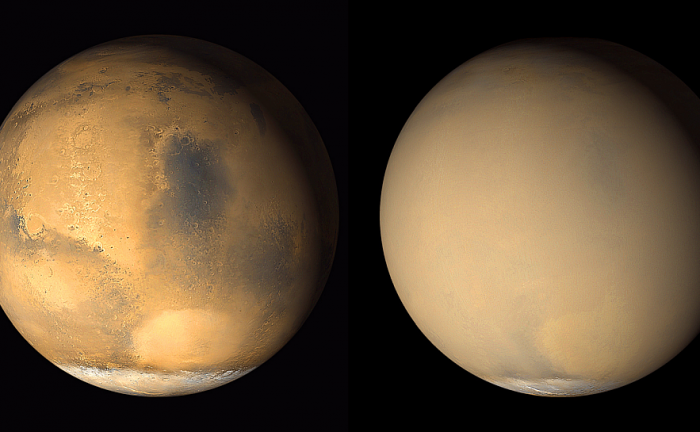

| Online: | |
| Visits: | |
| Stories: |

| Story Views | |
| Now: | |
| Last Hour: | |
| Last 24 Hours: | |
| Total: | |
JPL Predicts Mars’ Global Dust Storm To Arrive Within Weeks

Our ability to forecast the weather here on Earth has saved countless lives from the onslaught of hurricanes and typhoons. We’ve gotten better at predicting space weather, too, and that has allowed us to protect sensitive satellites and terrestrial facilities from bursts of radiation and solar wind. Now, it looks as though we’re getting closer to predicting bad weather on Mars. NASA’s Jet Propulsion Laboratory is forecasting the arrival of a global dust storm on Mars within weeks. The storm is expected to envelop the red planet, and reduce the amount of solar energy available to NASA’s rovers, Opportunity and Curiosity. The storm will also make it harder for orbiters to do their work. Dust storms are really the only type of weather that Mars experiences. They’re very common. Usually, they’re only local phenomena, but sometimes they can grow to effect an entire region. In rarer cases, they can envelop the entire globe. It’s these global storms that concern James Shirley, a planetary scientist at NASA’s Jet Propulsion Laboratory, in Pasadena, California. Shirley published a study showing that there is a pattern to these global storms. If his forecasted storm appears on time, it means that he has correctly determined that pattern. “Mars will reach the midpoint of its current dust storm season on October 29th of this year. Based on the historical pattern we found, we believe it is very likely that a global dust storm will begin within a few weeks or months of this date,” Shirley said. Predicting these huge dust storms will be of prime importance when humans gain a foothold on Mars. The dust could wreak havoc on sensitive systems, and can limit the effectiveness of solar power for weeks at a time. But it’s not just future endeavours that are impacted by Martian dust storms. Spirit and Opportunity had to batten down the hatches when a global dust storm interrupted their exploration of Mars in 2007.
“We had to take special measures to enable their survival for several weeks with little sunlight to keep them powered.
John Callas is JPL’s project manager for Spirit and Opportunity. He describes the precautions that his team took during the 2007 dust storm: “We had to take special measures to enable their survival for several weeks with little sunlight to keep them powered. Each rover powered up only a few minutes each day, enough to warm them up, then shut down to the next day without even communicating with Earth. For many days during the worst of the storm, the rovers were completely on their own.” We have observed 9 global dust storms on Mars since the first time in 1924, with the most recent one being the 2007 storm that threatened Spirit and Opportunity. Other storms were observed in 1977, 1982, 1994, and 2001. There’ve been many more of them, but we weren’t able to see them without orbiters and current telescope technology. And Earth hasn’t always been in a good position to view them. Global dust storms have left their imprint on the early exploration of Mars. In 1971, NASA’s Mariner 9 orbiter reached Mars, and was greeted by a global dust storm that made it impossible to image the planet. Only two weeks later, the Soviet Mars 2 and Mars 3 missions arrived at Mars, and sent their landers to the surface. Mars 2 crashed into the planet and was destroyed, but Mars 3 made it to the surface and landed softly. That made Mars 3 the first craft to land on Mars. However, it failed after only 14.5 seconds, likely because of the global dust storm. So not only was Mars 3 the first craft to land on Mars, it was also the first craft to be destroyed by a global dust storm. If we had been able to forecast the global dust storm of 1971, Mars 3 may have been a successful mission. Who knows how that may have changed the history of Martian exploration? James Shirley’s paper shows a pattern in global dust storms on Mars based on the orbit of Mars, and on the changing momentum of Mars as the gravity of other planets acts on it. Mars takes about 1.8 years to orbit the Sun, but its momentum change caused by other planets’ gravity is in a 2.2 year cycle. The relationship between these two cycles is always changing. What Shirley found is that global dust storms occur while Mars’ momentum is increasing during the first part of the dust storm season. When looking back at our historical record of Martian global dust storms, he found that none of them occurred in years when the momentum was decreasing during the first part of the dust storm season. Shirley’s paper found that current conditions on Mars are also very similar to other times when global dust storms occurred. Since we are much more capable of watching Mars than at any time in the past, we should be able to quickly confirm if Shirley’s understanding of Martian weather is correct.
The post JPL Predicts Mars’ Global Dust Storm To Arrive Within Weeks appeared first on Universe Today.
Source: http://www.universetoday.com/131285/jpl-predicts-mars-global-dust-storm-arrive-within-weeks/


